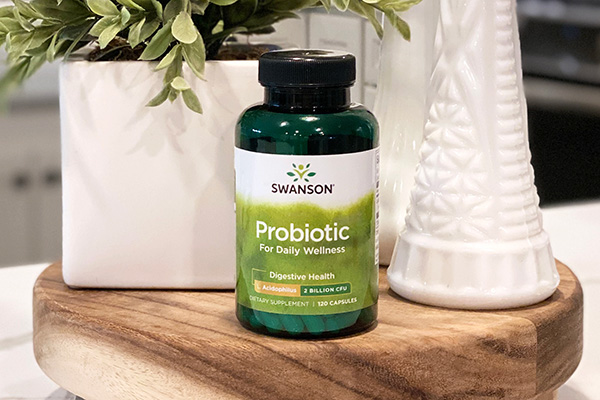Translating the Language of Probiotics
Whether you’re considering probiotics for digestive support, to give your immune system a boost, or any of the other numerous benefits of taking probiotics, you might be a little overwhelmed by all the options available.1 How do you choose between them?
When you look at most probiotics on the market today, one of the first things you’ll notice is that the labels focus on strains and CFU. So naturally, you may think the best probiotic has the most strains and the highest CFU count, right?
Not so fast. Like many things in life, probiotics aren’t that simple.
First off, there’s no established Recommended Daily Allowance (RDA) for probiotics, and researchers don’t know what an ideal gut flora looks like because each person’s gut flora is widely different, even among healthy people.2 What’s suitable for your digestive system and gut flora might not have the most strains or the highest CFU count.
So, what should you look out for? Our licensed nutritionist, Britta Sather has some quick tips that can help.
CFU Count & Probiotics
As mentioned, there’s no magic CFU number to shoot for, but a potency count of 50 billion CFUs or higher is usually recommended.3
If you are looking to support general digestive health, don’t feel pressured to go for huge CFU numbers. After all, there’s no way to tell if a particular CFU count will work better for you or not. Experiment to see what CFU count seems to deliver the results you are after. Swanson Health’s lineup of probiotics has options from 1 billion CFU to 66 billion CFU. We craft our probiotics so you can choose what works best for your goals.
Instead of getting hung up on CFU, focus instead on the specific probiotic strains that support the health benefits you’re seeking.
Strain Count & Probiotics
More strains might not always be better, especially if you have a specific reason for adding probiotics to your life in the first place. Remember that while there are general benefits to probiotics, like digestive health support, different strains affect the body differently.4
Think of it like spices in cooking. Spices make our food taste great and interesting, but you wouldn’t dump every spice from your pantry into a dish at once! Instead, you pick and choose based on what you’re cooking and how the flavors complement each other. Probiotic strains are similar.
Strains to Look For in Your Probiotics
Which strains should you pay attention to?
The Lactobacillus and Bifidobacterium species are good starting points, since they’re the most common in your gut. The probiotic yeast Saccharomyces boulardii is another strain you’ll see in many products.
Here are a few of the most popular (and well-researched) probiotic strains:
- Lactobacillus Species: the most populous bacteria in the small intestine are from the Lactobacillus (abbreviated “L.”) species; they produce lactase and lactic acid, helping to break down nutrients and support digestion
- L. acidophilus: one of the most researched (and most popular) strains; it’s often found in fermented foods and added to yogurts, and supports overall digestion, nutrient absorption, immune health and vaginal health
- L. rhamnosus: a popular probiotic among travelers for promoting digestive health while abroad; it also promotes vaginal health and plays an important role in maintaining immune function, plus is one of the most studied probiotic strains
- L. fermentum: promotes overall digestion
- L. reuteri: supports digestive, oral and immune health
- L. plantarum: promotes gastrointestinal health and immune health
- L. brevis: supports digestive health
- L. bulgaricus: promotes immune function and digestive health
- L. casei: supports digestion and immune system health
- L. gasseri: helps maintain immune health and digestive health
- Bifidobacterium Species: like the Lactobacillus species, Bifidobacterium (abbreviated “B.”) produce lactic acid and help maintain a healthy balance of gut flora; strains in this species also support immune system function
- B. bifidum: helps promote bacterial balance and the breakdown of nutrients
- B. lactis: promotes gastrointestinal health and immune function
- B. longum: supports digestive health and immune function
- B. breve: promotes colon health
- B. infantis: supports overall digestive system health
- Saccharomyces boulardii: a probiotic yeast and nourishes the intestines, supports the immune system, and helps protect other beneficial bacteria; it’s especially beneficial for frequent travelers
The list above covers the most common and well-researched strains, which you are most likely to find in a probiotic supplement. Hundreds more probiotic strains exist, but we simply don’t know enough about them to include them in our list (not to mention how long this post would get)!
Always check the label to make sure the probiotic you are considering contains the strains that support your health goals. If you don’t recognize a strain, look it up to see if scientific research backs its benefits!
For more information about probiotics, check out these posts on the Swanson blog: Trust Your Gut: Build a Healthier Gut with Probiotics and The 4 Steps to Choosing a Probiotic for You.
*These statements have not been evaluated by the Food and Drug Administration. These products are not intended to diagnose, treat, cure, or prevent any disease.

About Britta Sather, LN
Britta Sather is a Licensed Nutritionist with over 14 years of experience in the dietary supplement industry. She has a passion for holistic living and a lifelong belief in natural health practices. Her philosophy is that your health is the greatest investment you’ll ever make, but be sure and enjoy life along the way.
Sources
1. Health Benefits of Taking Probiotics. Harvard Health Publishing. Read source
2. 20 Things You Don't Know About the Human Gut Microbiome. National Library of Medicine. Read source
3. The 7 Best Foods & Supplements to Heal Your Gut Lining. Taz Bhatia, M.D., Integrative Medicine Doctor. Mind Body Green Read source
4. Microorganisms with Claimed Probiotic Properties. International Journal of Environmental Research and Public Health. Read source



